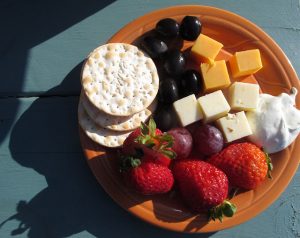Suggestions For Creating Healthy Snack Habits
 You are never too old to create healthy snack habits. Enjoying nutritious snacks helps curb hunger during the day, supplies essential nutrients, and keeps our energy from flagging.
You are never too old to create healthy snack habits. Enjoying nutritious snacks helps curb hunger during the day, supplies essential nutrients, and keeps our energy from flagging.
Whether teaching your children good snack habits, or teaching the child within you, the Mayo Clinic offers ten suggestions for making between meal fare fun and nutritious.
Naturally, if you are on a prescribed diet or eating plan, follow your doctor’s or dietician’s guidelines for meals and snacks.
Tips For Healthy Snacking
- Junk-food Free House. It is easier to resist temptation when there is none at hand. Leave the candy and bags of chips at the grocery store.
- Dip and Dunk. Dips and spreads make snacks more interesting. For instance, dunk graham cracker sticks or pieces of fruits in low-fat yogurt, put peanut butter on apples, bananas, or celery, and serve raw veggies with a dip of low-fat ranch dressing.
- Grains are Good. Whole grain cereals, crackers, pretzels, and breads are more nutrient rich and satisfying than more processed items.
- Breakfast Snacks. Mixing dry breakfast cereal with some dried fruit and nuts creates a crunchy, chewy, and sweet treat; or you can microwave some oatmeal and sprinkle it with berries, or stir in unsweetened applesauce and cinnamon.
- Novel Ideas. Try having some unusual and colorful snacks on hand such as red bell peppers cut into strips, pineapple chunks, mangoes, kiwi, or avocado.
- A Bit of Sweet. If you want to enjoy an occasional sweeter treat consider frozen fruit juice bars, dried fruits, smoothies made with plain yogurt and frozen or fresh fruit, or small pieces of dark chocolate (at least 70 percent cocoa).
- Easy Access. Have healthy snacks ready to grab. Servings of trail mix – cereal, dried fruits, crackers, and nuts – can be put into plastic snack bags or small storage containers. Have veggies washed, cut up and ready to eat. Leave bowels of fruit on the counter, or have small canned/packaged fruit (in its own juice) on hand.
- Food Fun. Get creative: put pieces of fruit on a chopstick to make a fruit kebob, eat pieces of fruit with a pair of chopsticks, build cracker skyscrapers, use pretzel sticks to spell words, use cookie cutters to make shapes from low-fat cheese slices or whole grain breads, or make doodles with string cheese.
- Snack Zones. To curb mindless munching, limit snacking to certain areas of the house such as the kitchen.
- Label Awareness. Food packaging can be deceiving so learn to read food labels. For example, “no sugar added” on a package means that no additional sugar was added during processing, but the food item might still be high in sugar. Avoid snacks containing trans-fats or hydrogenated oils.
Source: mayoclinic.com
Photo credit: torbakhopper – flickr
 Eating Disorder Self Test. Take the EAT-26 self test to see if you might have eating disorder symptoms that might require professional evaluation. All answers are confidential.
Eating Disorder Self Test. Take the EAT-26 self test to see if you might have eating disorder symptoms that might require professional evaluation. All answers are confidential.